A trip to Spain could hardly be called a bad thing, especially when the mission is to ride a new motorcycle model like the 2007 Triumph Tiger 1050. But as the 14-hour flight to southern Espana finally came to an end, I looked out the window and my stomach started to churn. Above were dark, menacing clouds and below lay the remains of what, I was told, was Spain’s worst rainstorm in two decades. Great, here I was on my first international press intro, really far from home, about to ride a completely unfamiliar motorcycle on roads I’d never seen before in less-than-ideal conditions. Talk about being thrown into the deep end.
Thankfully, the prayers I said the night before must have been heard, as we awoke to sunny skies and patches of benign white clouds-the perfect backdrop to test the new Tiger. The first of Triumph’s feline models rolled out of its Hinckley, England, factory in 1994. The Tiger’s intent at the time was adventure touring. Triumph believed that its rugged styling and big 19-inch front wheel helped it resemble those gnarly transcontinental offroad racebikes in the Paris-Dakar and such, street-legal versions of which sell quite well in Europe. Twelve years and a few variations later the Tiger is still a strong seller for the British company, despite the optimistic pretense that it had any off-road prowess.
Personally, I never cared for the earlier versions of the Tiger. The looks failed to grab me and the handling, though decent, was hampered by the big front tire. It was as though the bike had some kind of identity crisis.
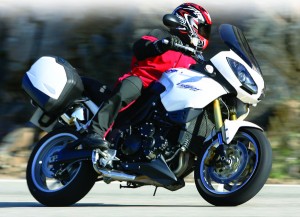
That is until now. Surveys showed that only a small percentage of Tiger buyers ever take their bikes off the pavement, so for 2007 the new Tiger has been redesigned from the ground up. Forget what you know about the old Tiger, Triumph’s new cat is out of the bag and this time its purpose is clear-to be the perfect all-round street motorcycle. At least that’s Triumph’s claim. So what’s different about it? Everything really-for starters, the 19-inch front wheel is gone, replaced with a 17-inch loop like the one on the back. A 43mm male-slider cartridge fork up front carries new opposed four-piston radial brake calipers, and the single shock out back has adjustable preload and rebound damping. The same 1,050cc three-cylinder engine that is shared between the Speed Triple and Sprint ST is now at the heart of the Tiger, too. Bore is the same as before at 79mm, but the new model has a greater stroke at just over 71mm. Compression has also been bumped up to 12:1 from its predecessor’s 11.6:1. All these changes translate into 102.9 horsepower and 64.1 lb-ft of torque at the rear wheel on the Borla Performance dyno, an improvement of 14.4 horsepower and almost 4 lb-ft of torque.
At the big roundtable at Triumph HQ, the decision was made to build a do-it-all motorcycle, hinging on the premise that if a rider could only have one motorcycle in their garage this should be the one. With the optional saddlebags you could go for a long day ride with the significant other, ditch the bags (and your significant other?) at your destination and go for a run up the local twisty bits. After you get your twisty fix, you can carve through city traffic and meet your S.O. for dinner…and apologize for leaving her (or him) behind.
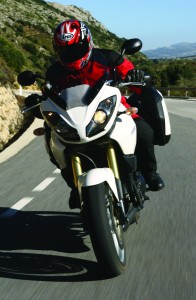
Of course, all of the claims were from the guys wearing the Triumph shirts. With a beautiful Spanish day in front of me, I set out to see if the new bike lived up to its billing. Our tour of southern Spain took us through the (very) twisty countryside, then on a quick jaunt through city streets, and ended with a rip down the highway-the three conditions the Tiger was made for.
Before even starting it the first thing I noticed was that this bike is tall. It almost has the profile of a dual-sport motorcycle, except that on a dual-sport the suspension will usually compress enough for me to comfortably touch the ground. The Tiger, not so much. The seat is almost 33 inches high, which is the same as the model it replaces. I could barely touch the ground with the tips of my toes. A beginner bike this is not! Although the tall seat height made it a chore for a shorty like me to throw a leg over it, once on I had a commanding view of what lay ahead.
On the road the new bike feels very nimble. Oddly, the 1,050cc triple felt rather anemic to my seat-of-the-pants dyno at first. I was expecting more “oomph.” Luckily, my suspicion that the altitude was robbing the bike of some power was confirmed once we received our test bike at the office‚Ķwhich overlooks the Pacific Ocean. Our test bike felt noticeably stronger at sea level than the one I rode in Spain, without the slightest hitch in the fuel injection. Throttle response is smooth at mid to high revolutions, but it is especially smooth at low engine speeds where, occasionally, my heavy right hand can loft the front end in the air without even trying. The only niggle I have is with the gearbox. At times first gear was hard to find in both the Spanish preproduction model and our test mule. Once engaged, however, slicing through all six gears is a breeze with or without the clutch, though the Spanish model did feel slightly more vague on the upshifts than the one we tested stateside.
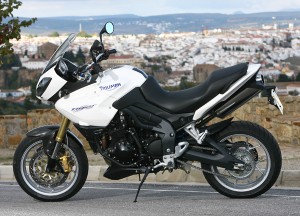
On the handling front, the 43mm male-slider fork-adjustable for spring preload, rebound and compression damping-helps the Tiger to track well and hold whatever line you like, although I had to back the compression off a couple turns to get a good feel for what the front end was doing. Working in conjunction with the preload- and rebound-adjustable rear shock, this combination soaks up bumps and provides a great ride. This proved to be very significant as the roads in Spain only became tighter as the ride went on. With tighter roads came greater lean angles and with greater lean angles came the need for sticky tires, something you just couldn’t get with the 19-inch front hoop on the old bike. Thankfully, the Tiger’s switch to 17-inch wheels not only emphasizes its pure street capabilities, it also opens the door to a wider range of tire options.
With the first phase of the ride out of the way our attention focused on the Tiger’s in-town practicality where, once again, the torquey triple has plenty of juice to get you out of tight situations. Just as impressive as the engine are the brakes. Stopping duties for the Tiger are handled by twin 320mm floating discs up front that are clamped by four-piston radially mounted calipers-the same pieces that are found on the Speed Triple. In the rear, a single 255mm disc is grabbed by a two-piston caliper. The Speed Triple is no slouch in the braking department, and thankfully none of that magic has been lost on the new Tiger. Unfortunately, I had to test the brakes when a fellow journalist took a nasty tumble on our ride, forcing me to perform a panic stop to avoid being tangled up in the mess. The lever provided a firm, linear feel and the initial bite was very progressive, allowing me to modulate the braking force easily. Thankfully, I was able to come away unscathed, which is more than I can say about my colleague. Around town the new bike is surprisingly nimble, too. Credit for that goes to the wide handlebar, which makes filtering through city traffic a breeze.
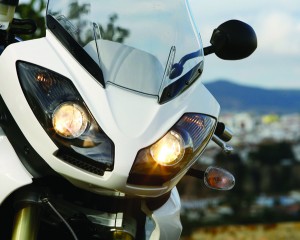
A few things stood out upon stretching the Tiger’s legs on the Spanish highway. For one, slower traffic actually keeps to the right-something you never see in my home state of California! Also the bike’s gearing is spot on, helping you to keep the Tiger in the sweet spot of the powerband in each gear, although with all that torque this isn’t that hard to accomplish. The windscreen, on the other hand, isn’t so nice, as unless I was in a racer tuck it would direct the wind right to my head, causing some annoying wind buffeting. It was nothing major but was definitely noticeable. A taller touring windscreen is an optional accessory, which should alleviate the buffeting problem.
Speaking of accessories, the Tiger is available with 16 options ranging from heated grips to a performance exhaust system. Our Spanish pre-production model was equipped with the two-box pannier kit, one of which is just big enough to fit a camera bag and my jacket. With both panniers filled, the Tiger could easily whisk you away for a weekend with everything you’d need. And if that’s not enough, a top trunk, seatbag and tankbag are also available, though neither bike we tested was equipped with any of these options.
Does the newest Tiger from Hinckley live up to all the claims? The original Tiger did pretty well for itself despite the fact that it was trying to live a double life. In 2005 we said that the Tiger was not the bike for true adventure tourers who ride in rough terrain, but gave it the benefit of the doubt and said that it made “A great back-road-and-dirt-road-traveling bike at a great price” (February 2005). This latest Tiger has finally discovered itself and the difference shows. The new engine has plenty of power and smooth delivery; the suspension and brakes look and feel like they came off a racebike, and the seating position ensures that you see everything in front of you. Gone is the last of the dirt capability, but on the road where it belongs, the Tiger is a fun motorcycle capable of going anywhere you want-provided that the route to your destination is paved. And if history is any indication, then the latest Tiger should continue to be a strong sales success like its predecessors.
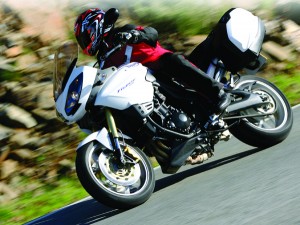
The Triumph website lists the new Tiger 1050 in its Urban Sports category, alongside the Sprint ST, Speed Triple and 675-three motorcycles that have already made a name for themselves in their respective arenas. Has Triumph done it again? Looking at the headlight cowl of the Tiger you get the feeling that it has something up its sleeve for its competitors. Look out world, there’s a new cat in the jungle and it’s ready to pounce.









I had a 2013 Tiger 800xc, the model with a 21″ front hoop. I never found it lacking in grip when riding in the twisties. Presently, I found a 2007 Tiger 1050 with but 23,800 miles on the odometer. With the 17″ wheels, as the article says, the choices of tires is excellent.
Being 6’3″ with long legs, this mounts seat height is spacious and the tall seat, along with the wide handlebars, adds to the comfort level for me. At the time I already have two motorcycles, but may have to add this one too. I need a bigger garage!